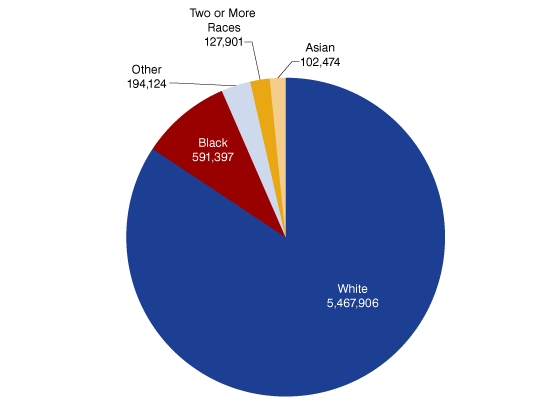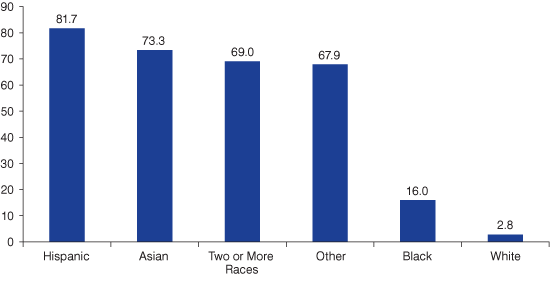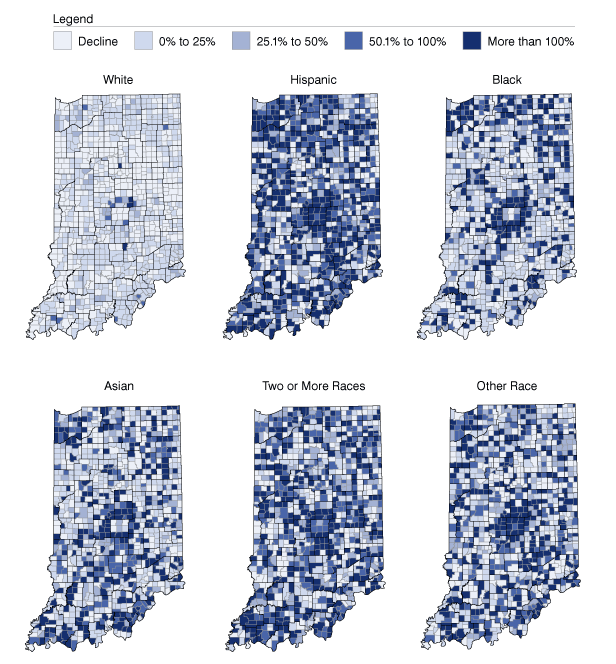Indiana's Minority Population Is Growing
Indiana is becoming more diverse. Between 2000 and 2010, Indiana's minority population grew 39 percent, with the addition of 336,237 people.1 Meanwhile, the state's white non-Hispanic population increased by a mere 1.3 percent, or 67,080 people.
Figure 1 shows that Indiana remains a predominately Caucasian state, with the white population comprising 84 percent of the total population. However, this is down from 87 percent in 2000.
Figure 1: Indiana's Population by Race, 2010

Note: There are 389,707 Hispanics in Indiana, which is considered an ethnicity and not a race, so Hispanics can be of any racial group.
Source: IBRC, using U.S. Census Bureau data
In both numeric and percentage terms, the Hispanic population has seen the most growth since 2000—gaining 175,171 individuals for an 82 percent increase (see Figure 2). In fact, the Hispanic population was the only minority group to see growth in all 92 counties during the decade.
Figure 2: Percent Change in Indiana Population by Race/Ethnicity, 2000 to 2010

Source: IBRC, using U.S. Census Bureau data
The minority population remains largely concentrated in Indiana's largest urban areas, with minorities comprising 45 percent of Lake County's population and 40 percent of Marion County's residents (see Table 1).
Table 1: Top 10 Counties with the Largest Minority Share of Total Population, 2010
| County | Minorities as a Percent of Total Population | Total Minority Population | White | White, Non-Hispanic | Black | Asian | Other Race | Two or More Races | Hispanic |
|---|---|---|---|---|---|---|---|---|---|
| Lake | 45% | 221,843 | 319,412 | 274,162 | 128,263 | 6,142 | 30,528 | 11,660 | 82,663 |
| Marion | 40% | 365,488 | 566,853 | 537,905 | 240,975 | 18,314 | 51,794 | 25,457 | 84,466 |
| St. Joseph | 24% | 65,230 | 209,972 | 201,701 | 33,958 | 5,036 | 10,255 | 7,710 | 19,395 |
| Allen | 24% | 83,540 | 281,653 | 271,789 | 41,618 | 9,721 | 11,890 | 10,447 | 23,093 |
| Elkhart | 23% | 45,004 | 163,792 | 152,555 | 11,307 | 1,915 | 15,620 | 4,925 | 27,886 |
| Tippecanoe | 20% | 33,925 | 145,190 | 138,855 | 6,913 | 10,730 | 6,175 | 3,772 | 12,947 |
| LaPorte | 19% | 20,772 | 93,787 | 90,695 | 12,001 | 583 | 2,553 | 2,543 | 6,093 |
| Cass | 16% | 6,342 | 34,385 | 32,624 | 578 | 419 | 2,974 | 610 | 4,897 |
| Clark | 15% | 16,345 | 95,961 | 93,887 | 7,661 | 875 | 3,273 | 2,462 | 5,350 |
| Vanderburgh | 15% | 26,623 | 154,882 | 153,080 | 16,347 | 2,003 | 2,370 | 4,101 | 3,873 |
Source: IBRC, using U.S. Census Bureau data
However, growth in the minority population was widespread across the state as shown in Figure 3.
Figure 3: Township Population Change by Race/Ethnicity, 2000 to 2010

Source: IBRC, using U.S. Census Bureau data
More data on Indiana's minority population is available for numerous geographies at www.stats.indiana.edu/topic/census.asp.
Notes
- For purposes of this article, the minority population is defined as the total population minus the white non-Hispanic population.
Rachel Justis
Geodemographic Analyst, Indiana Business Research Center, Indiana University Kelley School of Business
